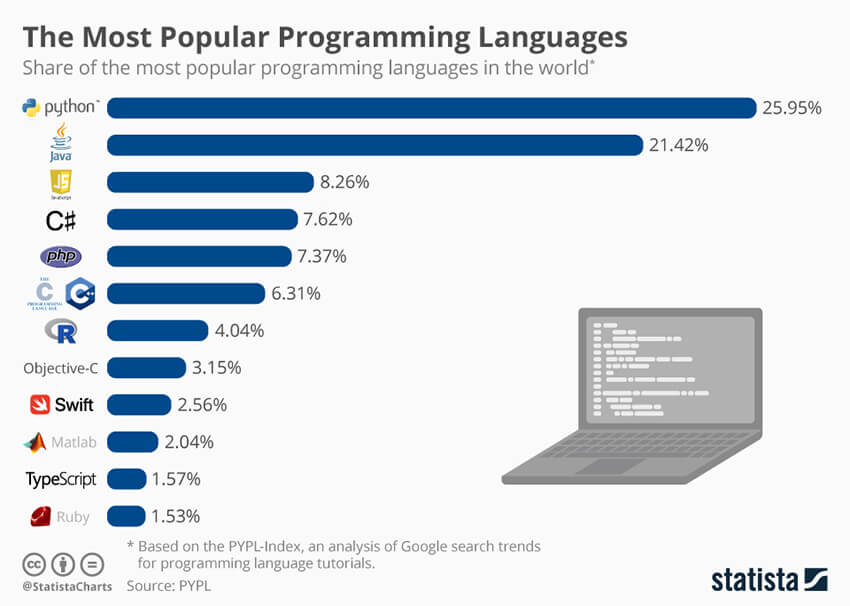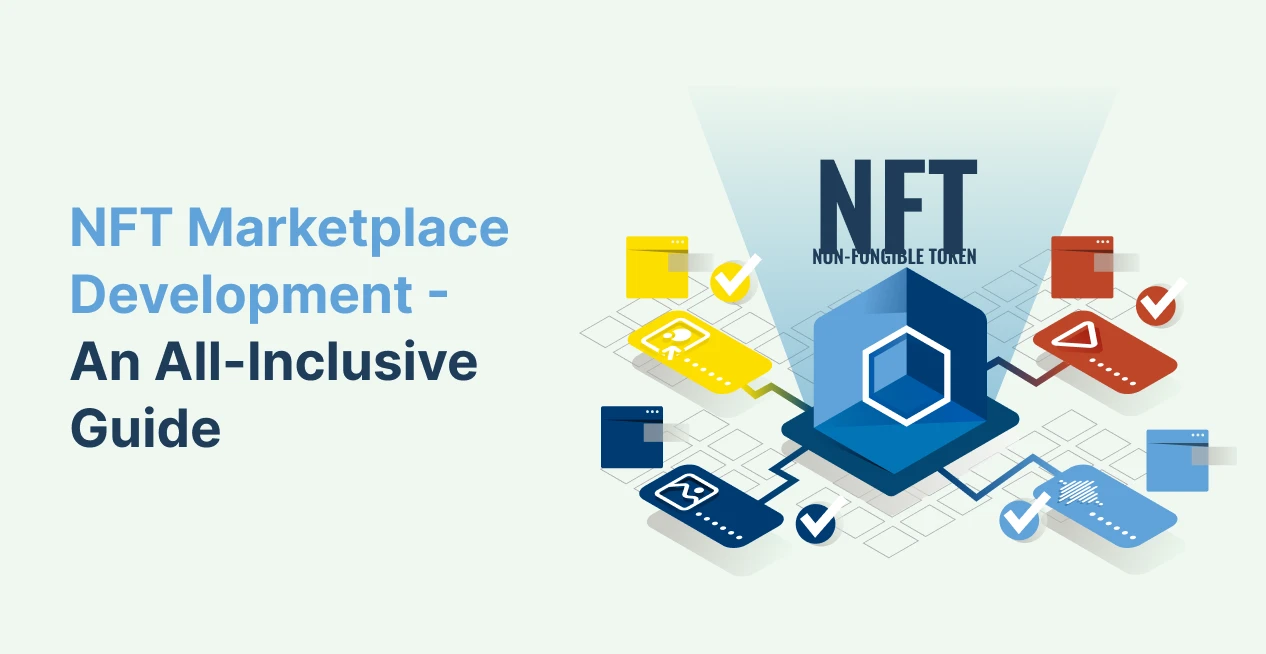Behind every software, web, and digital application that we use these days, the most hidden feature is the programming language. Any programmers, web developers, or mobile app development companies must keep updated on the latest industry trends and know about the latest emerging, top, and most popular programming languages.
There are many new programming languages to get a job in major companies as a developer like JavaScript, Python, PHP, etc. Yet, some languages are not convenient for modern languages that can handle the requirements of future technology.
If you want to choose the most popular from the top programming languages to fulfill your project’s need and purpose, look at the few best ones ruling the industry.
List of Most Popular Programming Languages to Know
Python
Java
C
There are many new programming languages for mobile and web app development available. Here we have listed the top programming languages of the future that are in demand today.
According to IEEE, the world’s most significant technical professional organization report, these are the top programming languages list for mobile and web app development.
Here you can see that Python is one of the top most popular programming languages in the world as of 2020. Developed in 1990 by Guido van Rossum and even he didn’t know that python would become the most accepted and top programming language in demand to learn first. It is easy to use and easy to install.
What is Programming Language?
Programming is giving a set of instructions to a computer to execute. Computers think in binary strings 1s and 0s, and due to this, programming language translates into something that humans can understand. A programming language is a set of series, commands, and instructions to create a software program.
Programmers write code in languages, which are high-level languages. Computer hardware recognizes when this code is compiled into a low-level language. Programming languages are classified into two levels, High-level and Low-level programming languages.
Low-level programming languages are closer to binary code. So, they’re more challenging for people to read (although they’re more straightforward than 1s and 0s). The advantage of low-level languages is that they’re quick and offer exact power over how the PC will work.
High-level programming languages are closer to how people communicate. High-level languages use words that are nearer to the words we use in our daily lives. This implies they’re simpler to program in than low-level programming languages, even though they set aside more effort to convert into machine code for the PC.
The difference in runtime between low-level and high-level programming languages is often milliseconds, as computers are powerful. High-level languages do the trick in most situations.
Read This: Mobile App Development Cost 2021
Types of Programming Languages
Let us have a look at the different types of top programming languages:
Procedural Programming Languages
The procedural functions can deal with the variables other than the value returns for these functions. This programming worldview got from structured programming, specifies a series of well-structured systems and steps to form a program.
This programming executes a series of statements that lead to a result. For the most part, this kind of programming utilizes many variables, heavy loops, and some other components, which is additionally a significant difference among procedural and functional languages. It gives a set of commands by segregating the program into functions, variables, restrictive operators, and statements.
Different Programming editors or IDEs assist clients with developing programming code using at least one programming language. Some of the examples of procedural programming languages are Java, Pascal, FORTRAN, BASIC, etc.
Functional Programming Languages
Functional programming is generally utilized for storing the information, often evading loops in the recursive function’s favor. This kind of programming language likewise focuses on the functions’ return values, and there is additionally a part of the side effects.
The establishment of functional programming is lambda calculus, which recursion to play out the calculations and utilizations of restrictive articulations. It doesn’t support iteration like loop statements and conditional statements like if-else.
Functional languages are simple to figure out emotional issues in their programming model, making it difficult to know. Yet, the programming code decodes into machine language which is likewise problematic for the programming of the framework. It may cause some algorithmic calls and change the parameters of needs.
Object-oriented Programming Languages
The object-oriented programming language’s main principle are encapsulation, expressed everything that needs. OOPs (Object-oriented Programming Systems) offer many highlights like encapsulation, abstraction, polymorphism, classes, inheritance, and Objects. This type of programming language thinks about the problem and then separates it into object collection, which offers the solution to resolve any particular issue.
Most multi-worldview languages are OOP languages, for example, Python, Java, JavaScript, C++, C#, and that is the beginning. This programming language regards the information as an array of internal information and external information. Encapsulation is the main principle as it guarantees secure code.
Read This: Mobile App Development – Step by Step Guide for 2021
Scripting Programming Languages
A script or scripting language is a kind of programming that gives a unique run-time setting that robotizes the task’s execution; these are like the assignments that are then again executed by some human administrator. The instructions are composed for a run time condition and make plugins and extensions for existing applications. The scripting programming languages are often procedural.
Most of them include a few object-oriented language components yet have their category as they are not developed languages for tremendous systems development support generally. The wording in the System administration, game applications, web applications, and interactive media. Rather than a compilation, it interprets the scripting languages now and again.
Logic Programming Languages
This kind of programming language is based upon formal logic. This means it would not tell the machine to do anything yet, employs restrictions on what it must consider doing. Logic programming languages are simpler to program in C in an object-oriented style.
In reality, many languages include features and ideas from various domains that support raising this kind of language’s practicality. Be that as it may, many programming languages are not convenient for other types of languages. PROLOG, ASAP (Answer Set programming), and Datalog are significant Logic programming languages, rules mentioned in classes.
| Read This: Top Mobile App Development Software 2021
Most Popular Programming Languages to Learn

The demand for the most popular programming languages keeps changing every year due to the development of most customizing applications globally. There are almost 600 programming languages in the world for many applications. Programming languages are evolving fast to meet the requirements of modern technologies. It is difficult to focus on HR leaders, tech recruiters, and managers to hire.
When choosing, search for the most popular at present or in the future, the most developing technology, and the skills required to fulfill your business goals. Here, we have the most popular programming languages list based on various metrics, such as popularity, career prospects, open-source, trends,career-prospects, etc.
1. Python
Python is a quick, easy-to-deploy, and easy-to-use programming language that is being generally used to create adaptable web applications. It is usually acknowledged as the best programming language to learn first. Instagram, YouTube, Pinterest, SurveyMonkey are built-in Python. Python gives excellent library support and has a massive engineer network.
The best thing about Python is that it considers ideal for both Android and iOS app development. This programming language is incredible for adaptability and readability that again makes it is the most used language for cross-stage versatile applications. Python also gives multithreading and multiprocessing that makes an app much better in execution and command response.
Pros:
- Extensive library support
- Creating and using classes and objects is easy thanks to OOP characteristics
- Focuses on code readability
- Ideal for building prototypes and testing out ideas faster
- Can scale even the most complex applications
Cons:
- Bad Threading due to Global Interpreter Lock
- Not suitable for mobile computing
- Slow execution time.
- Python’s database access layer is in the initial stage.
- Immature database access layer
2. Java
Java is generally used for building venture-scale web applications. Java is amazingly steady. Thus, numerous massive undertakings have received it. If you are looking for a development-based job at a vast association, Java is the language you ought to learn.
Java is additionally generally used in Android App Development. Luckily, Java is working on its shortcomings and making Java fit for Cloud through the GraalVM initiative. Also, in OpenJDK, there is a free option in contrast to the restrictive Oracle JDK. Java takes a shot at the principle of “write once; work anywhere.”
Pros:
- Follows the OOP paradigm
- Automatic memory allocation and garbage collection
- Supports multithreading
- Availability of Open-Source Libraries
- High-end Security
Cons:
- Templates Absent
- Some bugs may occur while running JAVA in a virtual machine – JVM
- Costly Memory Management
- Complex implementations due to poor garbage collection
- Slower than C and C++
3. C and C++ Programming language
Throughout the long term, C got one of the most used programming languages. C is often condemned for its inadvertent complexity, risky programming, and lack of features. Additionally, C is stage subordinate, i.e., C code isn’t versatile.
C++ is also generally used by serious programmers because it is much quick and stable. C++ additionally gives something called STL – Standard Template Library. STL is a pool of prepared-to-use libraries for various arithmetic operations, data structures, and algorithms. C/C++ is one exemption for apps like 3D Games.
Pros:
- Quicker execution of programs than most programming languages [C/C++]
- Offers an incredible level of movability [C]
- Runs near the system equipment and offers a low level of abstraction [C/C++]
- Programs are more effective and easier to understand [C/C++]
- Structures the reason for understanding more unpredictable programming languages [C/C++]
Cons:
- No run-time checking [C/C++]
- Complex syntax [C/C++]
- Not an easy first-choice for learning programming [C/C++]
- No garbage collection or dynamic memory allocation [C/C++]
- Issues of buffer overflow and memory corruption [C/C++]
4. JavaScript
JavaScript is mostly used to plan interactive frontend applications. For instance, when you click on a button that opens up a popup, the logic is JavaScript. It runs for all intents and purposes, from browsers, servers, mobile devices, and cloud to micro-controllers.
Pros:
- It is the programming language of the web
- Richer interface to a website
- Highly versatile
- Simplistic implementation
- Used for building a diverse range of applications
Cons:
- Allows only single inheritance
- The problem of Malicious Intent
- Interpreted Differently by Different Browsers
- Unavailability of copy or equal method
5. R Programming language
It is an open-source programming language that is especially incredible for UIs. The visual representation of data is significant. R can be perhaps the best language for creating beautiful animations, graphs, and many other UI components in the mobile app. R programming language is one of the most regularly used programming languages for Data Analysis and Machine Learning.
Pros:
- Active, mushrooming community
- Highly extensible
- Powerful package ecosystem
- Ability to runs on various OS
Cons:
- Poor memory management
- Lacks security features
- No strict programming guidelines
Read This: How to Patent an App Idea – The Only 10 Things You Need to Know
6. Gadddaddadada
6. GoLang
It was developed by two software engineers named Rob Pike and Ken Thompson. Go, otherwise called Golang, is a programming language built by Google. Go offers excellent help for multithreading. Thus, it is being used by many organizations that depend on distributed systems. Go is generally used in new companies in Silicon Valley. It is a pragmatic, easy to learn, scalable system and the best programming languages.
Pros:
- Backed by Google
- Easy-to-Learn
- Ideal for building SPAs (single-page applications)
- Fast
- ·Smart documentation
Cons:
- Lack of Versatility
- Implicit Interfaces
- No GUI library
- Virtual Machine Absence
- Poor library support
7. Swift
Created as an iOS programming language by Apple, Swift has become the best language for app development in the iOS domain. It is an outstanding choice for engineers as it offers many highlights and functionalities to integrate into an iOS app. Apple iPhone, for instance, has given a tough rivalry to Android.
Pros:
- Easy to add new features
- Projects are easier to scale
- Powerful and intuitive
- Easy-to-learn programming language
- Backed by Apple
- Interoperable with Objective-C
Cons:
- Considered as unstable language
- Limited community support
- Limited resources
- Needs regular updates
- No support for legacy projects
8. PHP
PHP is one of the most suggested programming languages for mobile apps that require database access. PHP is among the most popular backend programming language. It is an open-source language used for server-side scripting, command-line scripting, and coding applications. Even though PHP faces tough rivalry from Python and JavaScript, the market needs countless PHP engineers.
Pros:
- Lots of automation tools for testing and installing applications
- Easy to get started for making web pages
- Easy to learn
- Platform-independent
- Exceptionally compatible with smooth integration
Cons:
- Not suitable for large applications
- Poor error handling
- Not modular and is challenging to maintain
- Lacks in security
- The framework needs better error handling.
9. C#
According to Google Trends, the C# programming language’s popularity began to decline during the most recent two months in the United States. C# is a general-purpose programming language created by Microsoft. C# is primarily used for backend programming, building games (using Unity), building Windows mobile telephone apps, and many other use cases.
Pros:
- Supports type safety
- Follows a syntax like the C programming language
- Integrated with the .NET library
- Rich sets of library functions and data types
- Automatic scalable and updateable
Cons:
- Offers less flexibility than C+
- Integration with Windows
- Pointer types are not permitted.
- Requires decent effort and time to learn
- Resolving errors requires severe expertise and knowledge
10. MATLAB
Created by MathWorks and began as a matrix programming language where linear algebra programming was simple. MATLAB generally uses in the Computer Vision and Image processing industry too. It is a statistical analysis tool that various industries use for Data Analysis.
Pros:
- Platform-independent
- High coding efficiency and productivity
- The functionality extends by adding toolboxes
- Eases developing scientific simulation
- Doesn’t need a compiler for execution
Cons:
- Not free to use
- Slower due to being an interpreted programming language
- Requires extensive knowledge and experience
- Dealing with errors generated during cross-compilation
- Not many application
Most Popular Programming Languages: The Conclusion
Choosing the most popular programming languages is very important to fulfill the purpose of your project. The developer needs to understand the project’s requirements or type of software development and then choose the programming language. We have listed here the top programming languages of the future and their pros and cons to make the choice of programming language easier for you.
So, pick up a notepad, jot down all your requirements, and ping us now to get a custom solution developed with the best programming language for your project.








